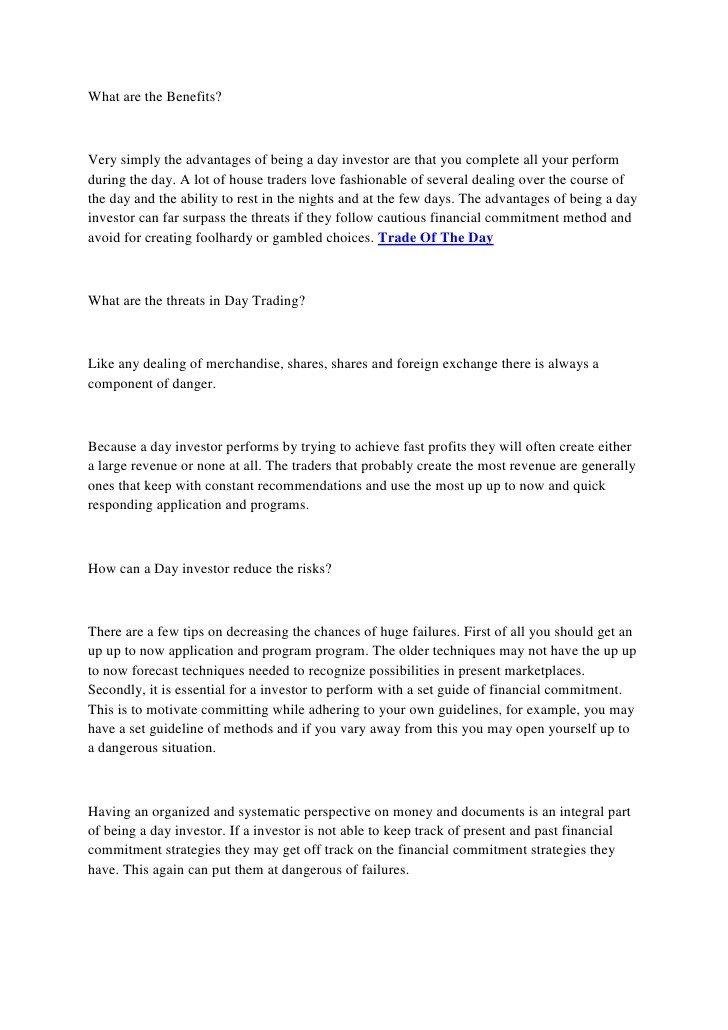Introduction to Day Trading
Post on: 31 Май, 2015 No Comment

For most people new to trading futures, day trading seems to be the most popular option, since most people view day trading as an opportunity to leave their mundane 9 to 5 jobs in order to pursue a career that will make them rich, while doing something they enjoy.
Then, reality hits…over 90% of day traders (and futures traders in general) are unprofitable. This is not to say that you can’t become profitable at day trading, but similar to trading in general, you should never try to rely upon your trading profits to pay your bills.
Gary Smith, author of Live The Dream By Profitably Day Trading Stock Index Futures in the mid-1990s, worked as a security guard to pay his bills. He then took out virtually all of his day trading profits and put them in mutual fund accounts, which he traded aggressively. He has lived a minimalist lifestyle while immersing himself into the markets.
To become proficient at day trading, you must be completely focused and be able to follow the markets closely throughout the primary trading session you intend to monitor.
Your goal should NOT be to rely on your trading profits and get rich as a day trader. Your goal should be to simply be profitable every month, and allow your account to compound. It might even then be a good idea to consider position trades as well once you become consistently profitable at day trading.
With all this in mind, lets discuss a couple different approaches to day trading.
Scalp Trading
Scalp trading seems to be the most appealing concept to new traders who are intent on day trading for a living. Scalping entails entering a position, and exiting within a few minutes to a couple hours. Scalpers tend to trade multiple times each day.
Scalpers will employ a variety of indicators, typically momentum type indicators and overbought/oversold indicators such as stochastics and RSI. They attempt to pinpoint low risk entry levels where they can maintain a tight stop, and hope to exit within a few price bars. Scalpers will often use 5 minute bars down to 1 minute bars. They then keep a close eye on the position in order to exit at the most opportune time.
In general, scalping tactics tend to be similar to swing trading, except the trades are obviously based upon a shorter time frame, as indicated.
One of the difficulties of scalping is that it requires focus throughout the trading day, because if you get up from your trading desk at just the wrong time, you may miss the best trade of the day. Furthermore, it is difficult to monitor more than a handful of markets.
Prior to the true advent of electronic trading, the odds were really stacked against the home based trader. Data fees, commissions and slippage all ate into the potential profits.
Now, however, commissions are very low, and the liquidity in many of the contracts that day traders tend to trade is quite sufficient to limit slippage. Furthermore, data fees for contracts such as the E-Mini stock index contracts are now quite low.
With all this in mind, most new day traders, whether they trade stocks, futures or forex, tend to focus on scalp trading, and the vast majority are unprofitable. Several successful commodity trading advisors and other traders have instead employed a different approach, discussed next.
Opening Range Breakout
The opening range breakout is a popular methodology for daytrading, particularly in the stock index futures. The opening range breakout is simply a strategy where a trader will enter a position long or short once a market breaks out of a range that may be defined by the previous days trading range, or the trading range established early in the trading session.
The strategy was originally popularized by Toby Crabel, who authored a book on trading the opening range breakout (Day Trading With Short Term Price Patterns and Opening Range Breakout) and a series of articles in Technical Analysis of Stocks and Commodities magazine back in the late 1980’s. He has since gone on to become a success Commodity Trading Advisor and hedge fund manager, with assets under management in excess of $1 billion.

Other significant futures traders and hedge fund traders that have employed a variation of opening range breakout include Monroe Trout and Mark Fisher. It is also notable that Crabel and Trout both trained under Victor Niederhoffer, who was known for quantifying his trading strategies. Trout and Crabel clearly went on to do the same, and have enjoyed enormous success.
Gary Smith also had a hand in popularizing this method of trading with his book “Live The Dream by Profitably Daytrading Stock Index Futures” that was published in 1995. Smith is a private trader who focused on day trading the NYFE and S&P 500 futures contracts back in the 1980’s through the mid-1990’s. Once he had saved enough of his profits, he focused more on trading mutual funds.
The reason that a number of CTAs employ some sort of opening range breakout strategy is that it is easy to implement across a diverse portfolio of markets. Trout (now Tewksbury Capital) and Crabel employ traders to execute these trades across a global portfolio. Many quant type funds have since followed suit, as short term trading has become more popular in the hedge fund world.
On the other hand, Smith simply focused on stock index futures, and learned all he could about the stock market in order to identify the best trading opportunities.
Generally speaking, the opening range breakout is employed to enter a position early in the trading day, and then, if the position is not stopped out, it will be held until the close, or even overnight. Price patterns may be employed to find opportunities that have greater odds for success.
Somewhat similar to the opening range breakout is the use of pivot points and pivot ranges, as Mark Fisher discusses in his book, The Logical Trader. These types of methods have also been popular among pit traders over the years. Pivot points are calculated in various ways by employing the previous days high price, low price, and closing price. Traders will then consider long positions if the price is trading above the pivot point, and short positions if price is trading below the pivot point.
As with any strategy you employ, you should consider conducting your own significant research and testing before ever employing a trading strategy with real money.
This concludes our brief introduction on day trading. Down the road, well provide more content about specific strategies.
Trading Futures and options involves a significant risk of loss. You should consider carefully whether futures or options are appropriate to your financial situation.














